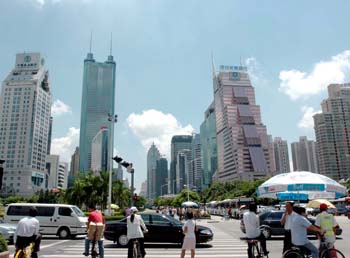| Tools: Save | Print | E-mail | Most Read |
| China Questions And Answers |
| Adjust font size: |
Q: China has adopted a progressive policy in opening up to the outside world. It established four special economic zones, then opened 14 coastal cities, and finally opened the whole country. Why does China adopt such an approach? What are the experiences and lessons? A: While deciding to restructure its economic system in 1978, China implemented the open policy step by step. Different from other countries, China opened one region after another and finally the whole country. Beginning in 1980, China set up five special economic zones in Shenzhen, Zhuhai and Shantou in Guangdong Province, Xiamen in Fujian Province and Hainan Province. In 1984, China opened 14 coastal cities – Dalian, Qinhuangdao, Tianjin, Yantai, Qingdao, Lianyungang, Nantong, Shanghai, Ningbo, Wenzhou, Fuzhou, Guangzhou, Zhanjiang, and Beihai. Then China established economic opening-up zones in the Yangtze River Delta, Pearl River Delta, South Fujian Triangle Zone, Shandong Peninsula and Liaodong Peninsula. Furthermore China opened Pudong New Area in Shanghai and some cities along the Yangtze River, thus a T-shaped opened economic zone composed of coastal cities and the areas along the Yangtze River has been formed. Since 1992, China has gradually opened capital cities of its inland provinces and autonomous regions as well as some bordering cities. At the same time, China has established 15 free trade zones, 49 national economic and technological development zones and 53 high and new-tech industrial development zones. As a result an opening-up pattern composed of coastal cities, Yangtze River cities, bordering areas and inland cities has been formed. This opening-up pattern with special economic zones and opened coastal cities as its main body, and pushing forward from the southern coastal areas to the central and west areas, is based on China's reality: vast territory and big economic gaps between different areas. Such a pattern has provided a guarantee for the irresistibility of opening-up and also avoided negative impacts on industrial development caused by blind opening-up. China's all-encompassing opening-up, which is based on its economic opening-up, involves exchanges and cooperation with other countries in science, technology, culture and education. In addition, China has opened up to all countries and regions in the world, regardless of their social systems, sizes or national strengths, and is willing to develop economic and trade relations with them on the basis of equality and mutual benefit. Currently, no country can develop if it is closed up to the outside world. China's experience proves that the opening-up not only has benefited China, but other countries as well. In the process of opening its market to others, a country can open wider to the international market. Certainly, in the process of opening up to the outside world, China has consistently maintained its sovereignty and economic social security, and paid attention to preventing and minimizing international risks. China entered the WTO in 2001, marking its shift from regional opening-up to all-encompassing opening-up and from unilateral opening-up to mutual opening among WHO member countries.
|
| Tools: Save | Print | E-mail | Most Read |
 |
| Related Stories |
|
Product Directory China Search |
Country Search Hot Buys |
